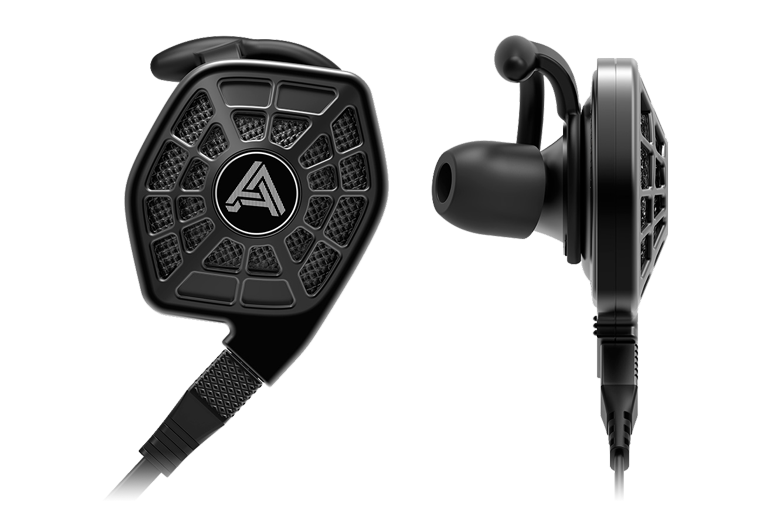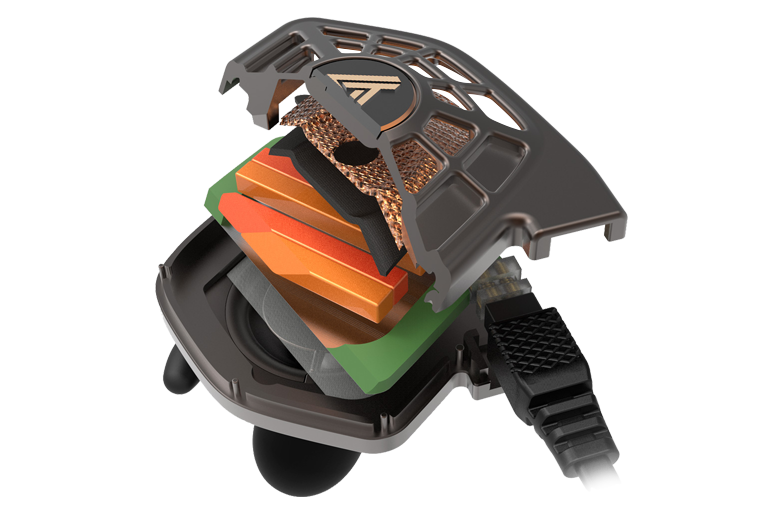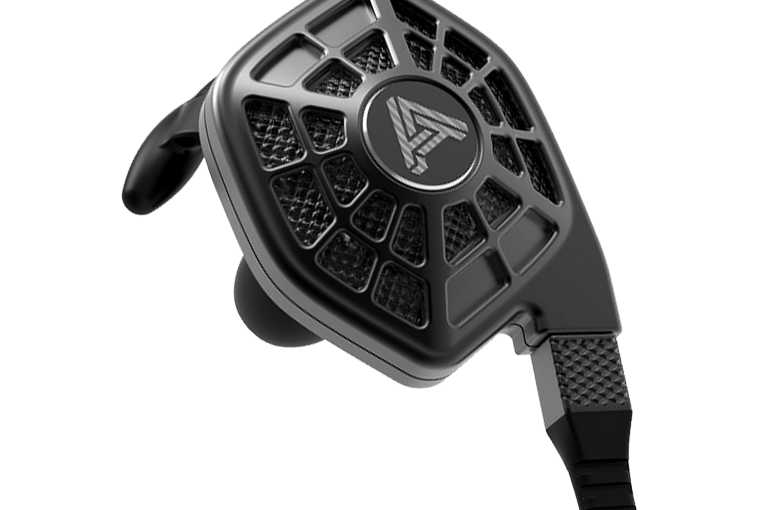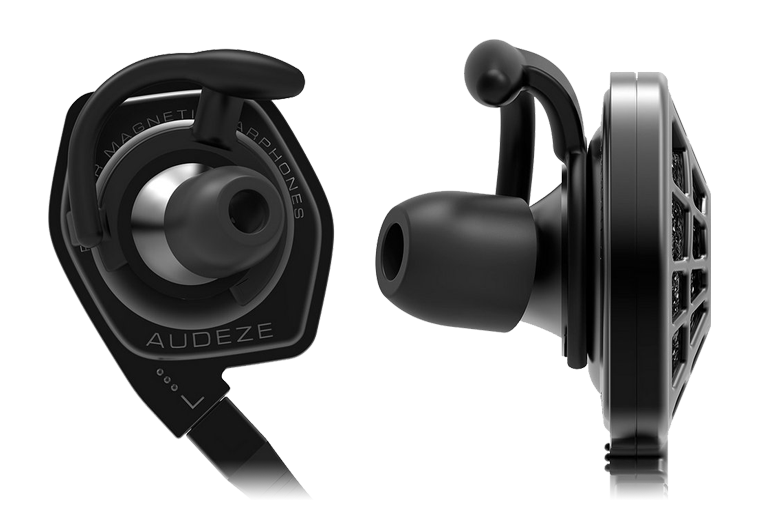 We’d never seen Brent Butterworth so enthusiastic about a set of earphones as he was about the Audeze iSine10s in his March 2017 review for SoundStage! Xperience. He felt that this idiosyncratic design offers such high performance and value that, as he declared in his review’s final sentence, “This is $4000 worth of sound for $400.”
We’d never seen Brent Butterworth so enthusiastic about a set of earphones as he was about the Audeze iSine10s in his March 2017 review for SoundStage! Xperience. He felt that this idiosyncratic design offers such high performance and value that, as he declared in his review’s final sentence, “This is $4000 worth of sound for $400.”
Part of what makes the iSine10s so unusual in looks and sound quality is Audeze’s use of planar-magnetic drivers, as Brent described:
Planar-magnetic drivers typically use a Mylar diaphragm to produce sound. (Audeze actually uses a proprietary film rather than Mylar.) The diaphragm is suspended between two metal plates, which are lined with rows of magnets. A wire voice-coil inlaid in the diaphragm accepts the signal from the source device. Planar-magnetic drivers are known for their clear, airy treble, natural-sounding midrange, and sometimes weak bass response. These drivers have been used in headphones and loudspeakers for decades, but in the past few years have enjoyed renewed attention thanks to acclaimed over-ear models from Audeze, HiFiMan, and other companies.

Planar-magnetic drivers are rarely used in earphones, but they’re what allow the iSine10s to provide their outstanding sound quality. Nonetheless, along with the unusual driver technology come compromises in noise isolation, and oddities in how the earphones look and fit:
Because the iSine10s’ planar drivers are 1.2” (30mm) across, they can’t fit inside the ear canals, as can typical 10mm dynamic-earphone drivers. So the iSine10s consist of little hexagonal panels that fit outside your ear and look like half of a toy TIE fighter from Star Wars. Because these parts of the iSine10s hang outside the ear, Audeze includes all sorts of hooks that let them grip the inside or outside of the pinnae (the outer ears).
Like most planar-magnetic headphones, the iSine10 earphones are open-backed. (Audeze’s specs describe them as “semi-open,” but my measurements and listening experience suggest that “open-backed” is more accurate.) This means that sounds from all around you can leak into your ears -- something that doesn’t occur with conventional earphones unless they’re equipped with eartips designed to let sound in.
Added to the iSine10s’ list of unique features is Audeze’s inclusion of two different cables: standard analog, with a 3.5mm connector; and Audeze’s proprietary Cipher digital cable. Which you choose affects not only the sound quality but the price -- the iSine10s sell for $349 USD with only the analog cable, or for $399 with both cables.

The Cipher cable comes with a Lightning connector for iOS devices, and built into it are a digital-to-analog converter (DAC), a digital signal processor (DSP), a headphone amplifier, and a microphone. Complementing the Cipher is Audeze’s Cipher app, which allows the user to adjust the iSine10s’ frequency response. (The app doesn’t work with the analog cable.)
Using the analog cable, Brent began his listening with the title track of I Only Have Eyes for You, by Lester Bowie’s Brass Fantasy (256kbps MP3, ECM):
This 1985 recording is an audiophile classic for its enormous sense of space -- though taped in a Brooklyn studio, it sounds as if it was recorded in a cathedral. With the analog cable, it was immediately apparent that the iSine10s didn’t sound like earphones at all. To me, they sounded much like a good set of over-ear, open-back headphones. The sound was far more spacious than I’d expect from earphones, and for the first time with earphones, I didn’t detect the resonance of a chamber or soundtube. I hadn’t necessarily noticed those resonances before, but the moment I first heard the iSine10s (at the 2016 Rocky Mountain Audio Fest, I think), I got the impression that other earphones had always added something to the sound that these weren’t.
The imaging of the instruments -- particularly drummer Phillip Wilson’s snare and hi-hat, and Bowie’s trumpet -- sounded far more precise and centered than I’m used to hearing from earphones. That doesn’t mean that the iSine10s were collapsing the soundstage -- I still experienced a huge ambience, and noticed discrete aural images of the horns accompanying Bowie at far left and far right.
I think a lot of enthusiasts might be willing to buy the iSine10s just on the basis of hearing a tune or two with the analog cable.

When Brent first listened with the Cipher cable, he used the Cipher app’s default settings and quickly discovered that this configuration didn’t sound at all like the analog cable, or as good (which correlated with the measurements he took):
[The Cipher cable] introduced a big peak at 3kHz, and elevated the mid-treble below about 8kHz from 8 to 12dB. This added brightness was easy to hear with the Bowie recording, and while the sound did seem more detailed and spacious, the sharp increase in treble robbed it of body and warmth. Treble-loving audiophiles would dig it, but as a guy who plays in jazz jam sessions a couple times a week, I know that real instruments don’t sound this bright. I quickly became annoyed and fatigued by the sound.
Brent’s solution was to tweak the iSine10s’ frequency response using the Cipher app:
The corrections I dialed in seemed extreme: -1dB at 2kHz, -6dB at 4kHz, -5dB at 8kHz, -5dB at 16kHz. Yet for my taste they were perfect, giving me a neutral balance reminiscent of the Sony MDR-7506s, probably the most popular pro-audio production headphones of all time. But the sound was much more detailed, subtle, and spacious than the MDR-7506s can deliver. This EQ setting sacrificed none of the iSine10s’ irresistible spaciousness and detail, but the timbres of instruments were much more natural, and the bass and the groove returned. Going back to the analog cable now no longer satisfied -- its treble sounded soft, and the midrange not as open, though it was still more open than that of most earphones. So I decided to stick with the Cipher cable for most of my listening, using the EQ settings noted above, and changing them by a dB or two when I felt the music required it. . . .
So many recordings I thought I knew well revealed previously unheard nuances through the iSine10s -- something I rarely find. For example, in the lushly arranged “Down to You,” from Joni Mitchell’s Court and Spark (256kbps MP3, Elektra/Asylum), the character of each instrument was easy to hear, as was its precise position on the soundstage. At the end of the orchestrated middle section, an oboe carries a brief section of the melody, then a clarinet picks it up. I knew the oboe was mostly in the right channel and the clarinet in the left, but through the iSine10s, each instrument had its own sense of space, as if I were hearing both being played in real space, each instrument’s position producing a different acoustical interaction with the room. The cellos’ sound was just as captivating -- I could clearly hear the trebly scrapings of bows against strings, but equally audible was all their gorgeous low-frequency resonance.
The iSine10s’ peculiar appearance and fit, as well as their lack of noise isolation, mean that, as Brent concluded, their “use will be limited to the sort of quiet environments in which earphones aren’t typically used.” That’s the iSine10s’ main downside. On the upside, “if you want top-notch, audiophile-grade sound you can enjoy at home and easily take along to your office, cubicle, or hotel room, I can’t think of a more practical and cost-effective way to get it.”

Although the high value presented by the Audeze iSine10s was of course a factor, it was primarily their exceptional sound quality that, when Brent’s review was published, earned these innovative earphones a Reviewers’ Choice award. That same sound quality is why we’ve now added them to our list of Recommended Reference Components. You can certainly pay a lot more for earphones these days, but there’s no guarantee you’ll get any better sound for $399 than the Audeze iSine10s can provide with their analog cable -- and especially with their Cipher cable, and the Cipher app configured just right.
Manufacturer contact information:
Audeze LLC
1559 Sunland Lane
Costa Mesa, CA 92626
Phone: (714) 581-8010
Fax: (702) 823-0333
E-mail: support@audeze.com
Website: www.audeze.com






















